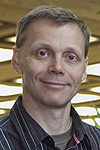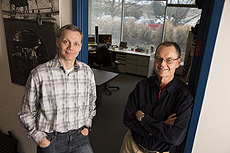Sergei Nagaitsev takes over as head of Accelerator Division
 |
|
Sergei Nagaitsev
|
On Dec. 1, Sergei Nagaitsev stepped into his new role as head of the Accelerator Division. He succeeds Roger Dixon, who led the division for almost 11 years. Dixon will stay on in an advisory role for a limited period.
He says Nagaitsev will be an exceptional leader.
"I have as much or more respect for Sergei and his scientific abilities, particularly in accelerators, than absolutely anyone I've ever known," Dixon said.
Nagaitsev plans to continue the work established under his predecessors while steering the division to support a research home for particle and accelerator physicists around the globe.
"Our vision is to be a laboratory where researchers from this country and the world want to do their experiments," Nagaitsev said. The division's most critical roles, he said, are to keep the accelerators running and to deliver what it promises to experiments such as NOvA and Muon g-2, as well as to outside projects such as the LHC upgrades.
Nagaitsev, an APS fellow, joined Fermilab in 1995 to develop an electron cooling system for the Recycler. He became head of the Recycler Department in 2004, and after six months in the position, rehabilitated the ailing accelerator, which had been experiencing problems for about two years.
"The only mistake he made there was that he said it was going to take longer than it took," Dixon said.
In 2005 Nagaitsev was appointed deputy director for Fermilab's ILC program. He assumed a leadership position in the Project X program in 2011.
"Sergei is well-known, not only inside the lab but internationally, for his many innovations contributing to the performance of Fermilab's accelerators over the last decade," said Associate Director for Accelerators Stuart Henderson. "His work on electron cooling, in particular, led to the amazing luminosity of the Tevatron collider."
Nagaitsev said he looks forward to meeting more of the Accelerator Division's 400 employees, including new faces that have joined since the time he worked as part of accelerator operations. He and Dixon will hold a meeting for all AD employees today to introduce Nagaitsev as AD head and to meet and chat with division members.
"We'll continue to innovate and think outside the box to provide, with our limited resources, various upgrades and capabilities we don't have in the toolkit right now," Nagaitsev said.
"I've been very attached to this division, and I care about it a lot," Dixon said. "I feel very good about leaving it in Sergei's hands."
—Leah Hesla
 |
Roger Dixon (right) handed over the leadership of the Accelerator Division to Sergei Nagaitsev on Dec. 1. Photo: Reidar Hahn
|
|